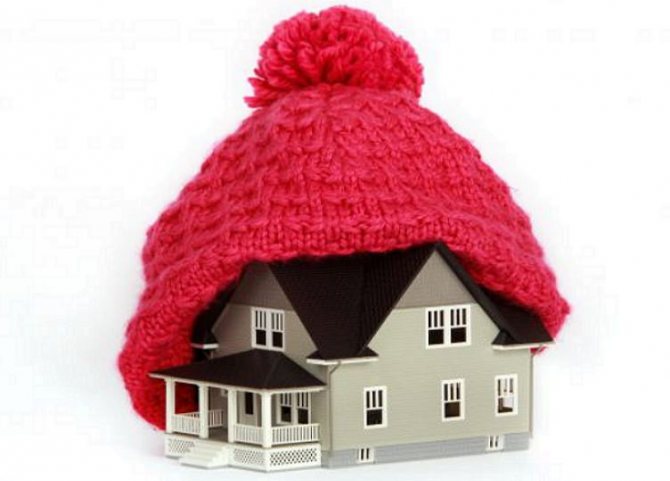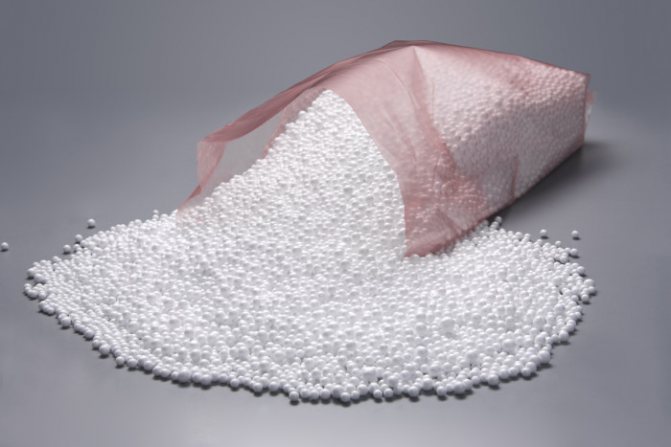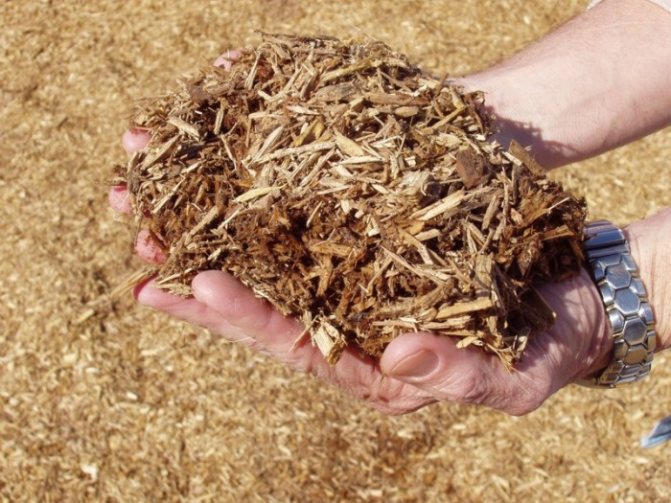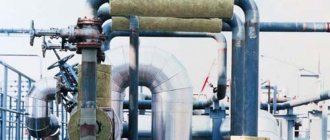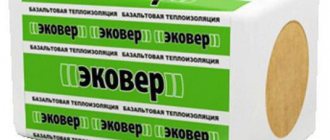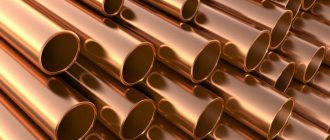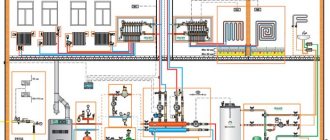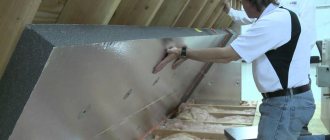How to choose insulation for your home
Our rating contains the most popular types of insulation. Before considering it, let us briefly touch on the main parameters that you should pay attention to when choosing:
- Thermal conductivity
... The indicator informs about the amount of heat that can pass through different materials under the same conditions. The lower the value, the better the substance will protect the house from freezing and save money on heating. The best values are 0.031 W / (m * K), the average values are 0.038-0.046 W / (m * K). - Vapor permeability
... It implies the ability to let moisture particles pass through (breathe) without retaining it in the room. Otherwise, excess moisture will be absorbed into the building materials and promote mold growth. Heaters are divided into vapor-permeable and impermeable. The value of the former ranges from 0.1 to 0.7 mg / (ppm Pa). - Shrinkage.
Over time, some heaters lose their volume or shape under the influence of their own weight. This requires more frequent fixing points during installation (partitions, clamping strips) or use them only in a horizontal position (floor, ceiling). - Mass and density.
The insulation characteristics depend on the density. The value varies from 11 to 220 kg / m3. The higher it is, the better. But with an increase in the density of the insulation, its weight also increases, which must be taken into account when loading building structures. - Water absorption (hygroscopicity).
If the insulation is directly exposed to water (accidental spillage on the floor, roof leakage), then it can either withstand it without harm, or deform and deteriorate. Some materials are not hygroscopic, while others absorb water from 0.095 to 1.7% of the mass in 24 hours. - Operating temperature range
... If the insulation is laid in the roof or directly behind the heating boiler, next to the fireplace in the walls, etc., then maintaining the elevated temperature while maintaining the properties of the material plays an important role. The value of some varies from -60 to +400 degrees, while others reach -180 ... + 1000 degrees. - Flammability
... Household insulation materials can be non-flammable, low-flammable and highly flammable. This affects the protection of the building in the event of accidental fire or intentional arson. - Thickness.
The section of the layer or roll insulation can be from 10 to 200 mm. This affects how much space is required in the structure for its placement. - Durability
... The service life of some heaters reaches 20 years, and others up to 50. - Simplicity of styling.
Soft insulation can be cut a little with a margin and they will tightly fill a niche in the wall or floor. Solid insulation needs to be cut exactly to size so as not to leave "cold bridges". - Environmental friendliness.
Implies the ability to release vapors into a dwelling during operation. Most often these are binder resins (of natural origin), so most materials are environmentally friendly. But during installation, some species can create an abundant dust cloud, harmful to the respiratory system, and prick hands, which will require protection with gloves. - Chemical resistance.
Determines whether it is possible to lay plaster over the insulation and paint the surface. Some species are completely resistant, others lose from 6 to 24% of their weight upon contact with alkalis or acidic environment.
The properties of heat-insulating materials in relation to construction are characterized by the following main parameters.
The most important technical characteristic of TIM is thermal conductivity - the ability of the material to transfer heat through its thickness, since the thermal resistance of the enclosing structure directly depends on it.It is quantitatively determined by the coefficient of thermal conductivity λ, which expresses the amount of heat passing through a sample of material with a thickness of 1 m and an area of 1 m2 at a temperature difference on opposite surfaces of 1 ° С for 1 h. The coefficient of thermal conductivity in reference and regulatory documents has the dimension W / (m ° С ).
The value of thermal conductivity of heat-insulating materials is influenced by the density of the material, the type, size and location of pores (voids), etc. The temperature of the material and, especially, its humidity also have a strong effect on thermal conductivity.
Methods for measuring thermal conductivity in different countries differ significantly from each other, therefore, when comparing the thermal conductivity of various materials, it is necessary to indicate under what conditions the measurements were taken.
Density - the ratio of the mass of dry material to its volume determined at a given load (kg / m3).
Compressive strength - This is the value of the load (KPa), causing a change in the thickness of the product by 10%.
Compressibility - the ability of a material to change its thickness under a given pressure. Compressibility is characterized by the relative deformation of the material under a load of 2 KPa.
Water absorption - the ability of the material to absorb and retain moisture in the pores (voids) in direct contact with water. The water absorption of thermal insulation materials is characterized by the amount of water that a dry material absorbs when kept in water, referred to the weight or volume of the dry material.
To reduce water absorption, leading manufacturers of heat-insulating materials introduce water-repellent additives into them.
Sorption moisture - equilibrium hygroscopic moisture content of the material under certain conditions for a given time. With an increase in the moisture content of thermal insulation materials, their thermal conductivity increases.
Frost resistance - the ability of a material in a moisture-saturated state to withstand repeated alternating freezing and thawing without signs of destruction. The durability of the entire structure significantly depends on this indicator, however, data on frost resistance are not given in GOST or TU.
Vapor permeability - the ability of the material to provide diffusion transfer of water vapor.
Vapor diffusion is characterized by resistance to vapor permeability (kg / m2 · h · Pa). The vapor permeability of TIM largely determines the moisture transfer through the enclosing structure as a whole. In turn, the latter is one of the most significant factors affecting the thermal resistance of the building envelope.
In order to avoid the accumulation of moisture in the multilayer enclosing structure and the associated drop in thermal resistance, the vapor permeability of the layers should increase in the direction from the warm side of the fence to the cold side.
Air permeability... The lower the air permeability of TIM, the higher the thermal insulation properties. Soft insulating materials allow air to pass through so well that air movement has to be prevented by the use of special windscreens. Rigid products, in turn, have good air tightness and do not need any special measures. They themselves can be used as windscreens.
When installing thermal insulation for external walls and other vertical structures exposed to wind pressure, it should be remembered that at a wind speed of 1 m / s and higher, it is advisable to assess the need for wind protection.
Fire resistance - the ability of the material to withstand exposure to high temperatures without ignition, damage to the structure, strength and other properties.
According to the flammability group, thermal insulation materials are divided into combustible and non-combustible. This is one of the most important criteria for choosing a thermal insulation material.
Unlike many other building materials, the brand of insulating material reflects not the strength, but the average density, which is expressed in kg / m3 (p0). According to this indicator, TIM have the following brands:
Especially low density (ONP) 15, 25, 35, 50, 75,
Low density (NP) 100, 125, 150, 175,
Medium density (SP) 200, 250, 300, 350,
Dense (PL) 400, 450, 500.
· The grade of the insulation material indicates the upper limit of its average density. For example, brand 100 products may have p0 = 75-100 kg / m3.
Rating of the best home insulation
| Nomination | a place | Name of product | price |
| The best basalt heaters | 1 | Rockwool | 695 ₽ |
| 2 | Hotrock smart | 302 ₽ | |
| The best polystyrene foam insulation | 1 | Technicol XPS Technoplex | 1 100 ₽ |
| 2 | Penoplex Comfort | 980 ₽ | |
| The best foam insulation | 1 | Knauf Therm House | 890 ₽ |
| 2 | PSB S 15-O | 1 688 ₽ | |
| The best fiberglass insulation | 1 | Isover Warm House | 660 ₽ |
| 2 | Ursa geo | 800 ₽ | |
| Best polyester fiber insulation | 1 | Shelter EcoStroy ShES Arctic | 1 780 ₽ |
Organic thermal insulation materials.
Organic thermal insulation materials, depending on the nature of the feedstock, can be conditionally divided into two types: materials based on natural organic raw materials (wood, woodworking waste, peat, annual plants, animal hair, etc.), materials based on synthetic resins, the so-called thermal insulation plastics.
Organic thermal insulation materials can be rigid and flexible. The rigid ones include wood-based, fibreboard, fibrolite, arbolite, reed and peat, and flexible - construction felt and corrugated cardboard. These insulating materials are characterized by low water and biological resistance.
Wood fiber insulation boards are obtained from wood waste, as well as from various agricultural waste (straw, reeds, fire, corn stalks, etc.). The board manufacturing process consists of the following main operations: crushing and grinding of wood raw materials, impregnation of the pulp with a binder, forming, drying and trimming the boards.
Fiber boards are produced with a length of 1200-2700, a width of 1200-1700 and a thickness of 8-25 mm. According to their density, they are divided into insulating (150-250 kg / m3) and insulating-finishing (250-350 kg / m3). The thermal conductivity of insulating boards is 0.047-0.07, and that of insulation-finishing boards is 0.07-0.08 W / (m- ° C). The ultimate bending strength of the slabs is 0.4-2 MPa. Fiberboard has high sound insulation properties.
Insulating and insulating - finishing boards are used for heat and sound insulation of walls, ceilings, floors, partitions and ceilings of buildings, acoustic insulation of concert halls and theaters (suspended ceilings and wall cladding).
Arbolite is made from a mixture of cement, organic aggregates, chemical additives and water. As organic aggregates, crushed waste of wood species, chopping of reeds, a fire of hemp or flax, etc. are used. mixtures into molds and its compaction, hardening of molded products.
Thermal insulation materials from plastics. In recent years, a fairly large group of new thermal insulation materials from plastics has been created. The raw materials for their manufacture are thermoplastic (polystyrene, polyvinyl chloride, polyurethane)
and thermosetting (urea - formaldehyde) resins, gas-forming and foaming agents, fillers, plasticizers, dyes, etc. In construction, plastics of a porous-cellular structure are most widely used as heat- and sound-insulating materials. The formation in plastics of cells or cavities filled with gases or air is caused by chemical, physical or mechanical processes or a combination of these.
Depending on the structure, thermal insulation plastics can be divided into two groups: foamed plastics and cellular plastics. Foam plastics are called cellular plastics with low density and the presence of non-communicating cavities or cells filled with gases or air. Porous plastics are porous plastics, the structure of which is characterized by interconnecting cavities. Of greatest interest for modern industrial construction are polystyrene foam, polyvinyl chloride foam, polyurethane foam and mipora. Expanded polystyrene is a material in the form of a white solid foam with a uniform closed-cell structure. Expanded polystyrene is produced by the PSBS brand in the form of plates with a size of 1000x500x100 mm and a density of 25-40 kg / m3. This material has a thermal conductivity of 0.05 W / (m- ° C), the maximum temperature of its application is 70 ° C. Plates made of expanded polystyrene are used to insulate the joints of large-panel buildings, insulate industrial refrigerators, and also as sound-insulating gaskets.
The main properties of thermal insulation materials. Medium grades.
The properties of heat-insulating materials in relation to construction are characterized by the following main parameters.
The most important technical characteristic of TIM is thermal conductivity
- the ability of the material to transfer heat through its thickness, since the thermal resistance of the enclosing structure directly depends on it. It is quantitatively determined by the coefficient of thermal conductivity λ, which expresses the amount of heat passing through a sample of material with a thickness of 1 m and an area of 1 m2 at a temperature difference on opposite surfaces of 1 ° С for 1 h. The coefficient of thermal conductivity in reference and regulatory documents has the dimension W / (m ° С ).
The value of thermal conductivity of heat-insulating materials is influenced by the density of the material, the type, size and location of pores (voids), etc. The temperature of the material and, especially, its humidity also have a strong effect on thermal conductivity.
Methods for measuring thermal conductivity in different countries differ significantly from each other, therefore, when comparing the thermal conductivity of various materials, it is necessary to indicate under what conditions the measurements were taken.
Density
- the ratio of the mass of dry material to its volume determined at a given load (kg / m3).
Compressive strength
- This is the value of the load (KPa), causing a change in the thickness of the product by 10%.
Compressibility
- the ability of a material to change its thickness under a given pressure. Compressibility is characterized by the relative deformation of the material under a load of 2 KPa.
Water absorption
- the ability of the material to absorb and retain moisture in the pores (voids) in direct contact with water. The water absorption of thermal insulation materials is characterized by the amount of water that a dry material absorbs when kept in water, referred to the weight or volume of the dry material.
To reduce water absorption, leading manufacturers of heat-insulating materials introduce water-repellent additives into them.
Sorption moisture
- equilibrium hygroscopic moisture content of the material under certain conditions for a given time. With an increase in the moisture content of thermal insulation materials, their thermal conductivity increases.
Frost resistance
- the ability of a material in a moisture-saturated state to withstand repeated alternating freezing and thawing without signs of destruction. The durability of the entire structure significantly depends on this indicator, however, data on frost resistance are not given in GOST or TU.
Vapor permeability
- the ability of the material to provide diffusion transfer of water vapor.
Vapor diffusion is characterized by resistance to vapor permeability (kg / m2 · h · Pa).The vapor permeability of TIM largely determines the moisture transfer through the enclosing structure as a whole. In turn, the latter is one of the most significant factors affecting the thermal resistance of the building envelope.
In order to avoid the accumulation of moisture in the multilayer enclosing structure and the associated drop in thermal resistance, the vapor permeability of the layers should increase in the direction from the warm side of the fence to the cold side.
Air permeability
... The lower the air permeability of TIM, the higher the thermal insulation properties. Soft insulating materials allow air to pass through so well that air movement has to be prevented by the use of special windscreens. Rigid products, in turn, have good air tightness and do not need any special measures. They themselves can be used as windscreens.
When installing thermal insulation for external walls and other vertical structures exposed to wind pressure, it should be remembered that at a wind speed of 1 m / s and higher, it is advisable to assess the need for wind protection.
Fire resistance
- the ability of the material to withstand exposure to high temperatures without ignition, damage to the structure, strength and other properties.
According to the flammability group, thermal insulation materials are divided into combustible and non-combustible. This is one of the most important criteria for choosing a thermal insulation material.
Unlike many other building materials, the brand of insulating material reflects not the strength, but the average density, which is expressed in kg / m3 (p0). According to this indicator, TIM have the following brands:
Especially low density (SNP) 15, 25, 35, 50, 75,
Low density (NP) 100, 125, 150, 175,
Medium density (SP) 200, 250, 300, 350,
Dense (PL) 400, 450, 500.
The grade of the insulation material indicates the upper limit of its average density. For example, brand 100 products may have p0 = 75-100 kg / m3.
138. Inorganic heat-insulating materials for general construction purposes. (2-3 examples with the decree of basic sv)
Inorganic thermal insulation materials
- mineral wool and products made from it (mineral wool slabs, mats, cylinders, etc.), light and cellular concrete (aerated concrete and foam concrete), glass fiber, foam glass, thermal insulation materials from expanded vermiculite, perlite, etc. Mineral wool products are obtained by processing rocks or metallurgical slags into a melt, from which a glass-like fiber is formed. The average density of thermal insulation materials made of mineral wool is 35-350 kg / m3. A distinctive feature is low strength properties and increased water absorption, therefore, when using it, it is necessary to take into account the field of application and carry out high-quality installation. Modern heat-insulating mineral wool heaters are produced with the addition of hydrophobic additives, which reduces water absorption during their transportation and installation.
139. Organic thermal insulation materials for general construction purposes. (2-3 examples with the decree of basic sv)
Organic thermal insulation materials
produced from wood waste (fiberboard, chipboard), peat (peat) and agricultural waste (reeds, straw, etc.), etc. These thermal insulation materials, as a rule, are characterized by low water and biological resistance. These disadvantages are absent in gas-filled plastics (expanded polystyrene, polyethylene foam, foam glass, cellular plastics, honeycomb plastics, etc.) - highly efficient organic thermal insulation materials with an average density of 10 to 100 kg / m3. A distinctive feature of most organic heaters is low fire resistance (the temperature of use that these thermal insulation materials have on average is up to 150 ° C), therefore, in structures they are used in conjunction with non-combustible materials (three-layer panels, plaster facades, walls with cladding, etc.).
140. Thermal insulation materials for the insulation of industrial equipment and pipelines (give 2-3 examples with the decree of basic sv)
Nomenclature of domestic thermal insulation materials
designed for thermal insulation of pipelines is not too diverse.It is represented by traditionally used products: <> mineral wool stitching mats without lining or in covers made of metal mesh, fiberglass or kraft paper on one or both sides (GOST 21880-94, TU 36.16.22-10-89, TU 34.26.10579-95 etc.) <> mineral wool products with a corrugated structure for industrial thermal insulation (TU 36.16.22-8-91) <> mineral wool heat-insulating plates on a synthetic binder with a density of 50 ... 125 kg / m3 (GOST 9573-96) <> products from glass staple fiber on a synthetic binder (GOST 10499-95). In a small volume, products are produced from super-thin glass and basalt fibers with and without various binders (TU 21-5328981-05-92, TU 95.2348-92, TU 5761-086011387634-95, etc.). For the insulation of pipelines with a temperature of up to 130 ° C, shells made of slow-combustible phenolic-resole foam FRP-1 (GOST 22546-77) are used. To insulate pipelines with a temperature of 400 ... 600 ° C, rigid molded lime-silica products (shells and segments according to GOST 24748-81) and perlite-cement shells (TU 36.16.22-72-96) are used as the first layer of a multilayer thermal insulation structure.
For cold water pipelines and pipelines with negative coolant temperatures, filling polyurethane foam (OST 6-55-455-90) and PSB-S expanded polystyrene shells are used. Both materials belong to the combustible group in accordance with GOST 30244. For this purpose, structures based on mineral wool and glass fiber materials with a vapor barrier layer are also used, characterized by low thermal efficiency and durability.
Inorganic thermal insulation materials.
Inorganic thermal insulation materials include mineral wool, glass fiber, penny glass, expanded perlite and vermiculite, asbestos-containing thermal insulation products, cellular concrete, etc.
Mineral wool and products from it. Mineral wool is a fibrous thermal insulation material obtained from silicate melts. The raw materials for its production are rocks (limestones, marls, diorites, etc.), waste from the metallurgical industry (blast furnace and fuel slags) and the building materials industry (broken clay and silicate bricks).
The production of mineral wool consists of two main technological processes: obtaining a silicate melt and converting this melt into the finest fibers. The silicate melt is formed in the cupola furnaces of shaft smelting furnaces, into which mineral raw materials and fuel (coke) are loaded. The melt with a temperature of 1300-1400 ° C is continuously discharged from the bottom of the furnace.
There are two ways to convert the melt into mineral fiber: blowing and centrifugal. The essence of the blowing method lies in the fact that a stream of water vapor or compressed gas acts on the stream of liquid melt flowing out of the cupola taphole. The centrifugal method is based on the use of centrifugal force to transform the melt jet into the finest mineral fibers 2-7 microns thick and 2-40 mm long. The resulting fibers are deposited in the fiber deposition chamber on a moving conveyor belt. Mineral wool is a loose material consisting of the finest intertwined mineral fibers and a small amount of glassy inclusions (balls, cylinders, etc.), the so-called beads.
The fewer the cotton balls, the higher its quality.
Depending on the density, mineral wool is subdivided into grades 75, 100, 125 and 150. It is fire-resistant, does not decay, is low-hygroscopic and has a low thermal conductivity of 0.04 - 0.05 W (m ° C).
Mineral wool is fragile, and a lot of dust is generated during its installation, therefore, the wool is granulated, i.e. o turn into loose lumps - granules. They are used as heat-insulating backfill for hollow walls and ceilings. The mineral wool itself is, as it were, a semi-finished product from which various heat-insulating mineral wool products are made: felt, mats, semi-rigid and rigid plates, shells, segments, etc.
Glass wool and glass wool products. Glass wool is a material composed of randomly arranged glass fibers obtained from molten raw materials.The raw material for the production of glass wool is a raw material mine for glass melting (quartz sand, soda ash and sodium sulfate) or glass breakage. The production of glass wool and glass wool products consists of the following technological processes: melting glass melt in bath furnaces at 1300-1400 ° C, glass fiber production and molding of products.
Fiberglass from the molten mass is obtained by drawing or blowing methods. Fiberglass is pulled out by bar (by heating glass rods until melted, followed by pulling them into glass fiber, wound on rotating drums) and by spunbond (by pulling fibers from molten glass through small filter holes with subsequent winding of fibers on rotating drums) methods. In the blowing method, molten glass melt is atomized by a jet of compressed air or steam.
Depending on the purpose, they produce textile and heat-insulating (staple) fiberglass. The average diameter of the textile fiber is 3-7 microns, and the heat-insulating fiber is 10-30 microns.
Glass fibers are considerably longer than mineral wool fibers and are characterized by greater chemical resistance and strength. The density of glass wool is 75-125 kg / m3, thermal conductivity is 0.04-0.052 W / (m / ° C), the maximum temperature for using glass wool is 450 ° C. Mats, plates, strips and other products, including woven ones, are made of fiberglass.
Foam glass is a heat-insulating material of a cellular structure. The raw material for the production of foam glass products (slabs, blocks) is a mixture of finely crushed glass broken with gassing (ground limestone). The raw mixture is poured into molds and heated in furnaces to 900 ° C, while the particles melt and the gasifier decomposes. The evolved gases swell the molten glass, which, when cooled, turns into a durable material with a cellular structure
Foam glass has a number of valuable properties that distinguish it favorably from many other heat-insulating materials: foam glass porosity 80-95%, pore size 0.1-3 mm, density 200-600 kg / m3, thermal conductivity 0.09-0.14 W / ( m, / (m * ° С), the ultimate compressive strength of the foam glass is 2-6 MPa In addition, the foam glass is characterized by water resistance, frost resistance, fire resistance, good sound absorption, it is easy to handle with a cutting tool.
Foam glass in the form of plates with a length of 500, a width of 400 and a thickness of 70-140 mm is used in construction to insulate walls, ceilings, roofs and other parts of buildings, and in the form of semi-cylinders, shells and segments - to insulate heating units and heating networks, where the temperature does not exceed 300 ° C. In addition, foam glass serves as a sound-absorbing and at the same time finishing material for auditoriums, cinemas and concert halls.
Asbestos-containing materials and products. Materials and products made of asbestos fiber without additives or with the addition of binders include asbestos paper, cord, fabric, plates, etc. Asbestos can also be part of the compositions from which various heat-insulating materials are made (sovelite, etc.). In the materials and products under consideration, the valuable properties of asbestos are used: temperature resistance, high strength, fiber, etc.
Aluminum foil (alfol) is a new heat-insulating material, which is a tape of corrugated paper with aluminum foil glued on the crest of the corrugations. This type of heat-insulating material, unlike any porous material, combines the low thermal conductivity of the air trapped between the sheets of aluminum foil with the high reflectivity of the surface of the aluminum foil itself. Aluminum foil for thermal insulation purposes is produced in rolls up to 100 mm wide and 0.005-0.03 mm thick.
The practice of using aluminum foil in thermal insulation has shown that the optimal thickness of the air gap between the foil layers should be 8-10 mm, and the number of layers should be at least three. The density of such a layered structure made of aluminum (foil 6-9 kg / m3, thermal conductivity - 0.03 - 0.08 W / (m * C).
Aluminum foil is used as reflective insulation in heat-insulating layered structures of buildings and structures, as well as for thermal insulation of surfaces of industrial equipment and pipelines at a temperature of 300 ° C.
Thermal insulation materials, their brands and characteristics.
Materials characterized by a low ability to conduct heat are referred to as heat-insulating materials (TIM). By type of feedstock (GOST 16381-77) distinguish between inorganic (mineral fiber, expanded perlite) and organic (foam, cellulose fibers) materials. Mixtures of organic and inorganic materials are classified as inorganic if the content of the inorganic component exceeds 50% by weight. By structure thermal insulation materials are divided into fibrous (mineral or organic fibers), cellular (foam, foam glass, foam concrete) and granular (expanded perlite, vermiculite). In terms of flammability, they distinguish between non-combustible, hardly combustible and combustible materials. By density, TIM is subdivided into grades (from 15 to 500). In terms of thermal conductivity (W / m ° C), materials are distinguished between low (up to 0.06), medium (0.06-0.115) and high thermal conductivity (0.115-0.175) at an average temperature of 25 ° C. By area of application thermal insulation materials are divided into general construction and technical. A separate subgroup includes refractory light weights - materials for high-temperature insulation.
To date, the following patterns are taking shape in the field of production and use of TIM. Firstly, among domestic enterprises, the focus on the production of thermal insulation products based on mineral wool remains. This is due to the technological capabilities of most of the enterprises built in the 50-80s of the last century. At the same time, as the technological resource develops, a tendency is formed to re-equip them with modern technologies, as a rule, involving the use of basalt wool, fiberglass, polystyrene or polyurethane foam. Secondly, the majority of large foreign manufacturers of thermal insulation materials (or equipment for their manufacture) are beginning to invest in organizing the production of thermal insulation in Russia.
In the sphere of small and medium-sized production of heat-insulating materials, directions are being formed for the use of modern technologies for the production of basalt and glass fibers (and products based on them), TIM, which were traditionally classified as "local", such as peat plates, ecowool, cement fiberboard; the production of aerated concrete is widely developed.
Aerated concretes and concretes based on light (or super-light) aggregate retain their position as one of the most effective and economical building materials. Aerated concrete is widely used in France, Scandinavian countries, Finland and Poland. Manufacturing of aerated concrete products is based on factory technologies. The production of foam concrete products is feasible both in the factory (industrially and at mini-factories) and at the construction site using mobile units.
In recent years, the construction of low-rise housing from monolithic foam concrete or from large elements manufactured at the construction site has found application. In connection with the rise in the cost of energy, the proportion of autoclave-free aerated concrete is increasing.
In the field of using thermal insulation materials, a number of topics are emerging, some of which are already becoming traditional. These are issues related to the fire resistance of TIM and structures based on them, the vapor permeability of such structures, issues related to the thermophysical efficiency of certain materials, issues of the stability of the properties of these materials during operation.Until now, the subject of discussion is the question of which insulation is better: outside, inside, or something else?
Foam plastics have the best thermophysical properties. For the most part, these are materials from expanded and extruded polystyrene or polyurethane foam and, in smaller volumes, from expanded polyethylene or rubber. Unfortunately, any organic matter is combustible, and synthetic at the same time releases far from harmless substances. This implies the use of such materials in special structures in compliance with safety standards during installation and operation. Most polymers begin to degrade when exposed to UV radiation. To a lesser extent, this applies to foams (although the released styrene has a cumulative property, that is, it accumulates in the body), to a greater extent - to foamed polyethylene. Polyethylene was originally conceived as a packaging material, with a guarantee of decomposition within one to two years in atmospheric conditions. Foamed rubber is a technical insulation. The condition for maintaining the normalized permeability of the building structure is important both from the point of view of maintaining its durability and from the point of view of comfort in the room. Any well-formed building structure has the ability to "breathe", that is, to let air, vapor-air mixture, water vapor pass through itself. This, on the one hand, helps to remove enzymes (harmful products of human metabolism contained in the air), excess water vapor from the premises, and on the other hand, there is no spontaneous accumulation of moisture in the wall itself.
The emergence of a vapor barrier in the form of one or another TIM prevents free moisture exchange and leads to the accumulation of moisture in the structure (the appearance of mold, fungi, freezing cracking, thermal conductivity) and to a decrease in air quality in the room itself. The window opens and all the heat saved by the thermal insulation goes through it to heat the street. Thermal insulation materials with close to zero vapor permeability (some foams, foamed polyethylene, foam glass), it is advisable to use where this "property" becomes positive: in ceilings over foundations, roofs, basement structures.
Thermal insulation based on mineral fibers for the most part refers to fire-resistant or non-combustible materials. Its vapor permeability is also not satisfactory. The durability of basalt and glass fibers is high for both domestic and imported materials. Unfortunately, the same cannot be said about materials based on mineral wool, which are mainly produced by Russian enterprises. The raw materials and technologies used in some of the enterprises do not allow the production of fibers resistant to aggressive environments. Therefore, the products can (and should) be used only under special conditions for vapor barrier (from the premises), built-in waterproofing (on the outer area). It is not recommended to use such materials in such “advanced” structures as insulation systems with ventilated facades, or in systems of bonded (“wet” method) insulation.
Aerated concrete products can be more economically viable if the building codes are amended regarding their calculated thermal conductivity. The actual operational moisture content of aerated concrete is lower than those established by SNiP 8 and 12% for conditions A and B. This means that the calculated thermal conductivity should be set at a significantly lower level. In this case, the thickness of the walls made of aerated concrete with a density of 600 kg / m3 for the central regions of Russia will be 55-60 cm.
Heat-efficient structures of walls, ceilings, floors, special rooms must meet a number of requirements. First, to help reduce heat losses and maintain temporary stability for the period envisaged by the project.Secondly, to ensure the standards of fire safety imposed on the structure, even if it includes a combustible material. Thirdly, not to worsen the microclimate in the room and to improve the comfort and stay in it.
HEAT INSULATION MATERIALS BASED ON MINERAL FIBERS
Mineral wool is a fibrous material obtained from silicate rock melts, metallurgical slags or other silicate industrial waste or mixtures thereof. It consists of the finest intertwining fibers in a glassy state and non-fibrous inclusions in the form of droplets of solidified material. Depending on the purpose, mineral wool is produced of three types (GOST 4640-84): A - for the production of slabs of increased rigidity from hydromass, slabs of hot and semi-dry pressing (grade 200) and other products on a synthetic binder; B - for the production of plates of grades 50, 75, 125, 175, cylinders, semi-cylinders on a synthetic binder, mats, cords and felt; B - for the production of slabs on a bituminous binder. For cotton wool supplied for the manufacture of products, or commercial cotton, the acidity modulus, average fiber diameter, density, moisture content, and organic matter content are controlled.
Mineral wool boards on a synthetic binder are produced depending on the density of grades 50, 75, 125, 175, 200, 300 of the highest and first quality categories with or without modifying additives (GOST 9573-82). Plates of grades 200 and 300 are made only hydrophobized. The moisture content of the plates is not more than 1%. Plates 50 and 75 must be flexible enough to bend around a 217 mm diameter cylinder. Slab dimensions (mm): length 1000; width 500, 1000; thickness 20-100 with an interval of 10 mm.
The following are used as synthetic binders: phenolic alcohols (grades B, V, D), neutralized with ammonium sulfate with the addition of ammonia water; urea resin (KS-11), phenol-formaldehyde resin (SFZh-3056). Latexes of synthetic rubbers, emulsol, polyvinyl acetate dispersion are used as plasticizing additives that increase the flexibility of the cured resin film; compositions based on bentonite clays are used as water repellents; organosilicon compounds, etc.
Plates on a bituminous binder are subdivided, depending on the density and compressibility, into grades 75, 100, 150, 200, 250 (GOST 10140-80). Moisture by weight no more than 1%. Petroleum construction bitumens (GOST 6617-76) of grades BN-50/50, BN-70/30, BN-90/10 are used as a binder. Fusion of bitumen of various grades is possible. For the production of hard mineral wool slabs, bitumen emulsions and pastes are used, which, in addition to bitumen, include rosin, kaolin or clay, diatomite or tripoli.
Plates are used to insulate walls, roof structures; technological equipment and pipelines.
Mineral wool semi-cylinders and cylinders (for thermal insulation of pipelines), depending on the density (kg / m3), are divided into grades: 100, 150, 200 (GOST 23208-83). They are produced in lengths of 500, 1000 mm, with an inner diameter of 18-219 mm, and a thickness of 40-80 mm. The content of the synthetic binder is not more than 5%. Humidity no more than 1%.
Mineral wool vertical-layered mats (lamellas) are heat-insulating industrial structures, consisting of heat-insulating and cover layers. As a heat-insulating layer, strips are used, cut from mineral wool boards on a synthetic binder, rotated 90 degrees to impart greater rigidity. The protective cover layer is made of aluminum foil, duplicated with a glass mesh or fiberglass, foil-ruberoid, foil-insol, foil cardboard. Depending on the density, vertically layered mats are divided into grades 75 and 125 (GOST 23307-78 *). The moisture content of the products is not more than 1% by weight. Dimensions of mats (mm): length -600-1000; width 750-1260; thickness 40-100.
Mineral wool stitched mats are sheets of mineral wool with or without a covering material on one or both sides, stitched with wire or thread. The mats have good flexibility. By density (kg / m3) they are subdivided into grades 100, 125. Mats are produced with a length of 1000-2500 mm with an interval of 250 mm, a width of 500 and 1000 mm and a thickness of 40, 50, 60, 70, 80, 100, 120 mm.It is allowed, upon agreement with the consumer, to manufacture mats up to 6000 mm long and up to 2000 mm wide. Mats are used to insulate pipelines with a diameter of more than 273 mm and industrial equipment with a large radius of curvature at a temperature of the insulated surface from -180 to + 700 ° C.
A heat-insulating cord is a bundle with various braids (in the form of a mesh stocking) made of cotton, glass, nylon, lavsan thread or steel wire. To fill the mesh stocking, mineral, glass, basalt, mullite-silica, ceramic wool, as well as waste from the production of these materials, are used. Depending on the density of the cotton wool, the cord (TU 36-1695-79) has grades 100, 150, 200, 250, 300, 350. The length of the cord in the coil should be at least 15 m with a diameter of 30-50 mm and at least 10 m with diameter 60-90 mm. The largest mesh of the cord mesh is 6 mm. The thermal conductivity of a mineral wool cord at a temperature of 20 ± 5 ° C is 0.07 W / m ° C, glass and ceramic wool is 0.064 W / m ° C. The flexibility of the cord should ensure the possibility of free wrapping of a pipeline with a diameter of 15 mm with a cord diameter of 30-50 mm and a pipeline with a diameter of 30 mm with a cord diameter of 60 mm.
Heat-insulating cord is used to insulate pipelines with a diameter of up to 108 mm, with a significant number of bends. The maximum temperature for using the cord, depending on the thermal insulation material, is as follows: for mineral wool - 600 ° C; for glass -400 ° С; for ceramic (kaolinic) 1100 ° C.
Handbook of a specialist in the construction industry "Builder" 2/2004
Based on materials from the site: https://www.germostroy.ru/
16 popular materials: advantages and disadvantages of the best insulation
The market of insulation materials is represented by a huge variety of assortments. The most commonly used types are discussed below.
Basalt wool
It is a fibrous material. Of all types of insulation, it is the most popular, since the technology for its use is simple, and the price is low.
Advantages:
- Refractoriness;
- Good noise isolation;
- Frost resistance;
- High porosity.
Disadvantages:
- On contact with moisture, the heat retention properties are reduced;
- Low strength;
- Application requires additional material - film.
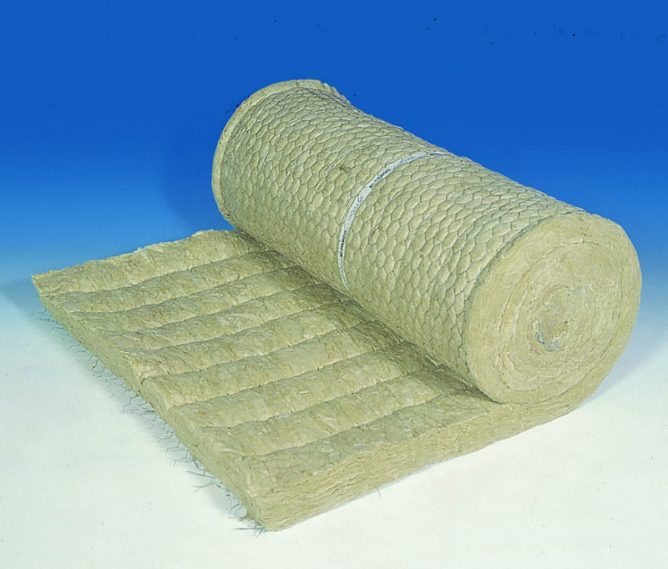
Glass wool
Manufacturing technology implies a similar composition with glass. Hence the name of the material. Benefits:
- Great soundproofing;
- High strength;
- Moisture protection;
- Resistant to high temperatures.
Disadvantages:
- Short service life;
- Less thermal insulation;
- Formaldehyde in the composition (not all).


Foam glass
For the manufacture of this material in production, glass powder and gas-generating elements are used. Pros:
- Waterproof;
- Frost resistance;
- High fire resistance.
Minuses:
- High price;
- Air tightness.
Organic products
According to the environmental factor, they are in the first place, but their use is not always relevant. The following raw materials can be used for production:
- wood fiber;
- paper;
- cork bark.
On their basis, a variety of insulation materials are obtained.
Cellulose wool
It is obtained from wood fiber. Of all organic products, cellulose wool is the most common. It is used in loose form or in the form of plates. Its use is limited by a number of disadvantages:
- low refractoriness (to compensate for this quality, ammonium polyphosphate can be added to the composition);
- susceptibility to mold and mildew.
The advantages of cellulose wool are good thermal insulation properties at a low cost. The installation process does not cause any particular difficulties.
Paper pellets
For their production, waste paper is mainly used. Processing with special salts makes the products non-flammable. Granular paper fills cavities and has good water repellency. The main disadvantage is the limited scope of application.
Also, during installation, you cannot do without the services of specialists, because such work requires certain skills.
Cork bark
Thermal insulation materials are obtained from it by pressing raw materials at a high temperature. They differ:
- ease;
- durability;
- bending and compressive strength;
- resistance to decay;
In order for the material not to ignite, the raw materials are treated with special synthetic impregnations, which negatively affects the environmental factor.
Products from inorganic raw materials
The basis is used:
- rocks;
- glass;
- polyurethane foam and polystyrene foam;
- foamed rubber;
- various types of concrete.
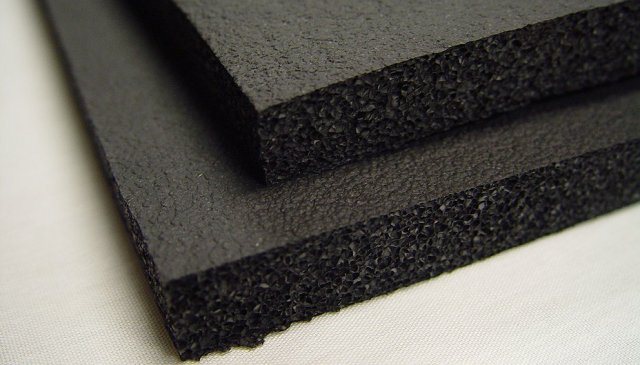

Thermal insulation materials have their own characteristics - consider the most common of them.
Stone wool
The manufacturing process involves rock, which melts and turns into fiber and air. Stone wool is used for wall insulation. The energy-intensive technological process is reflected in the high cost of the material. Another significant disadvantage is special disposal.
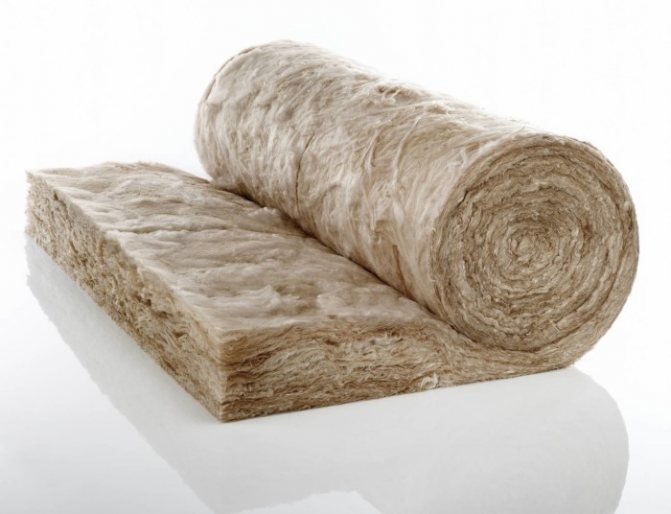

Stone wool is a fireproof material because it can withstand high temperatures. It is not subject to decay. Structures made of it have good thermal insulation parameters and high sound insulation.
Perlite
The properties of this volcanic rock were known back in the last century. When heated, its volume increases significantly. Thermal insulation with perlite does not cause any particular difficulties. The granules are poured or blown into the slots. It can also be part of the thermal insulation solution as the main component.


The thermal insulation materials obtained from it are environmentally friendly. The structure of pearlite does not change over time, therefore, the shrinkage of the heat-insulating layer does not occur. It is resistant to moisture and open fire.
The only drawback when using it is the pouring of granules from the voids during the laying of communications of already insulated structures.
Mineral wool
This is the most common heat insulator. It can be produced in various forms - these are plates, and cylinders, and mats, and loose cotton wool. Dolomites, basalts and other minerals are used as the main raw materials. Thermal insulation materials are made by extracting fibers from minerals and bonding them with special resins.
Mineral wool has a number of advantages:


- resistance to fungus;
- high fire safety;
- frost resistance;
- additional noise insulation;
- a good indicator of thermal insulation.
When choosing a material, one cannot but take into account its disadvantages. Cotton wool is highly toxic and therefore requires isolation from living quarters. Its installation must provide for vapor barrier, otherwise condensation will accumulate on the surface.
Foam glass
The cost of this material is quite high, and installation will require additional ventilation. For other properties, foam glass is superior to other inorganic products. It has a sufficiently strong structure that fasteners can be installed on it.
Foam glass is resistant to moisture and mold and has high frost resistance. All these factors ensure a long service life of the insulation.
Polyurethane foam
Modern thermal insulation materials cannot do without this representative. For insulation, polyurethane foam is used only in a liquid state. This requires a special installation in which the components are mixed with air. The result is an aerosol that is evenly applied to the surface.
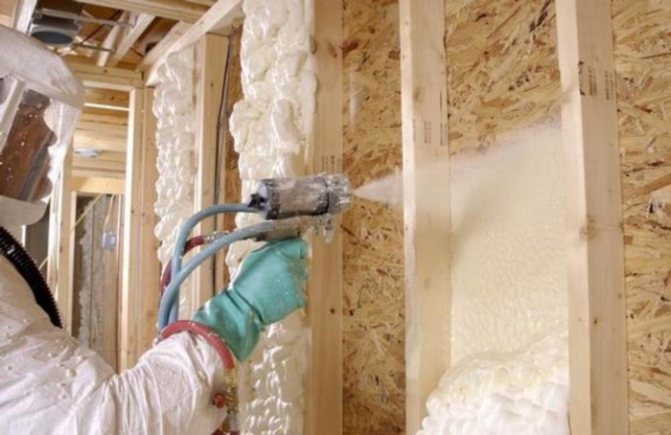

Uneven surfaces can be insulated with polyurethane foam; such installation takes a minimum amount of time. The undoubted advantage is the absence of joints during installation. Polyurethane is not affected by the biological environment, but it is highly flammable, as a result of which toxic gases are released.
Polystyrene foam
Represents balls of different diameters connected to each other. Get foam plates by pressing. The material is easy to install and stands out for such properties as strength and low cost.Insulation requires additional ventilation, because the foam "does not breathe".


Additional surface treatment is also required, because the structure is destroyed when exposed to ultraviolet rays. The same thing happens when exposed to moisture.
Expanded polystyrene
This material is much stronger than the previously discussed foam. It is not affected by moisture. The extruded polystyrene foam received an improved characteristic of thermal conductivity due to the integral microstructure. Air and moisture cannot penetrate into the material because the individual cells are isolated from each other and filled with air.
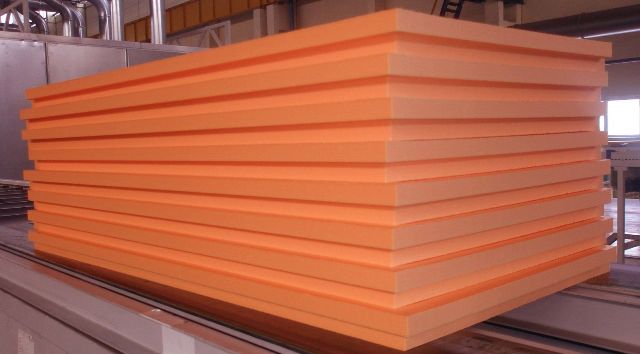

The only factor that extruded polystyrene foam does not resist is fire. Under its influence, it releases toxic substances. Also, insulation made from this raw material does not "breathe".
Reflective insulation
Heaters, called reflex, or reflective, work on the principle of slowing down the movement of heat. After all, every building material is able to absorb this heat and then emit it. As you know, heat loss occurs mainly due to the exit of infrared rays from the building. They easily penetrate even materials with low thermal conductivity.
But there are other substances - their surface is capable of reflecting from 97 to 99 percent of the heat reaching it. These are, for example, silver, gold and polished aluminum without impurities. By taking one of these materials and building a thermal barrier with a polyethylene film, you can get an excellent thermal insulator. Moreover, it will simultaneously serve as a vapor barrier. Therefore, it is ideal for bath or sauna insulation.
Reflective insulation today is polished aluminum (one or two layers) plus polyethylene foam (one layer). This material is thin, but gives tangible results. So, with a thickness of such a heater from 1 to 2.5 centimeters, the effect will be the same as when using a fibrous heat insulator from 10 to 27 centimeters thick. As an example, let us name Armofol, Ekofol, Porileks, Penofol.
What parameters should you pay attention to when choosing?
The choice of quality thermal insulation depends on many parameters. The methods of installation, and the cost, and other important characteristics, which are worth dwelling on in more detail, are taken into account.
Choosing the best heat-saving material, you must carefully study its main characteristics:
- Thermal conductivity. This coefficient is equal to the amount of heat that in 1 hour passes through 1 m of an insulator with an area of 1 m2, measured by W. The thermal conductivity index directly depends on the degree of surface moisture, since water passes heat better than air, that is, the raw material will not cope with its tasks.
- Porosity. This is the proportion of pores in the total volume of the heat insulator. The pores can be open or closed, large or small. When choosing, the uniformity of their distribution and appearance are important.
- Water absorption. This parameter shows the amount of water that can be absorbed and retained in the pores of the heat insulator in direct contact with a humid environment. To improve this characteristic, the material is subjected to hydrophobization.
- Density of thermal insulation materials. This indicator is measured in kg / m3. Density shows the ratio of mass to volume of a product.
- Humidity. Shows the amount of moisture in the insulation. Sorption humidity indicates the balance of hygroscopic humidity in conditions of different temperature indicators and relative humidity.
- Water vapor permeability. This property shows the amount of water vapor passing through 1 m2 of insulation in one hour. The unit of measurement for steam is mg, and the temperature of the air inside and outside is taken as the same.
- Resistant to biodegradation.A heat insulator with a high degree of biostability can withstand the effects of insects, microorganisms, fungi and in high humidity conditions.
- Strength. This parameter indicates the impact on the product will have transportation, storage, installation and operation. A good indicator is in the range from 0.2 to 2.5 MPa.
- Fire resistance. All parameters of fire safety are taken into account here: the flammability of the material, its flammability, smoke-generating ability, as well as the degree of toxicity of combustion products. So, the longer the insulation resists the flame, the higher its fire resistance parameter.
- Heat resistance. The ability of a material to resist temperatures. The indicator demonstrates the level of temperature, after reaching which the material's characteristics, structure will change, and its strength will also decrease.
- Specific heat. It is measured in kJ / (kg x ° C) and thus demonstrates the amount of heat that is accumulated by the thermal insulation layer.
- Frost resistance. This parameter shows the ability of the material to tolerate temperature changes, freeze and thaw without losing its main characteristics.
When choosing thermal insulation, you need to remember about a whole range of factors. It is necessary to take into account the main parameters of the insulated object, conditions of use, and so on. There are no universal materials, since among the panels, bulk mixtures and liquids presented on the market, you need to choose the type of thermal insulation that is most suitable for a particular case.
Main characteristics
When choosing one or another material, it is necessary to take into account all the characteristics that affect thermal conductivity and other factors for creating an optimal microclimate in a living room. Haste in such a serious matter is unnecessary, since the properties of thermal insulation materials determine the required level of living comfort. The main task of materials for creating high-quality thermal insulation is to prevent heat loss in the cold season and create a barrier to the penetration of heat in the hot season.
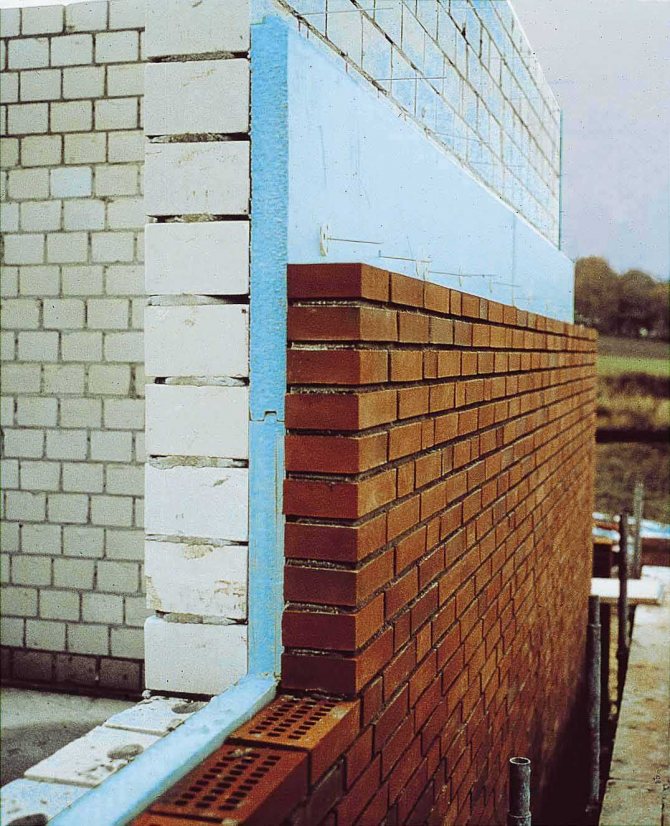

Correct thermal insulation significantly improves the comfort of your home.
A short excursion into school physics: heat transfer occurs in the movement of molecules. There is no way to stop it, but it is quite possible to reduce it. There is a rule: in dry air, the movement of molecules slows down as much as possible. This natural property is the basis for the production of any thermal insulation materials. This means that the air is “sealed” in any way possible - in capsules, pores or cells. Fundamental characteristics:
- Thermal conductivity. This property is considered basic for each type. This characteristic shows the amount of heat that can pass through a 1 m thick insulation on an area of 1 m2. Several factors affect thermal conductivity: the degree of porosity, humidity, temperature level, features of the chemical composition, and much more.
Thermal conductivity test of insulating materials
- Water absorption. The ability to absorb moisture in direct contact with it is an important selection criterion. This characteristic is especially important for rooms with high humidity.
- Density. The density index affects its mass and the degree of weighting of the structure.
- Biological stability. Bio-resistant material prevents the development of mold, fungi and pathogens.
- Heat capacity. The parameter is important in climatic conditions with abrupt and frequent temperature changes. Good heat capacity indicates the ability to accumulate the maximum amount of heat.
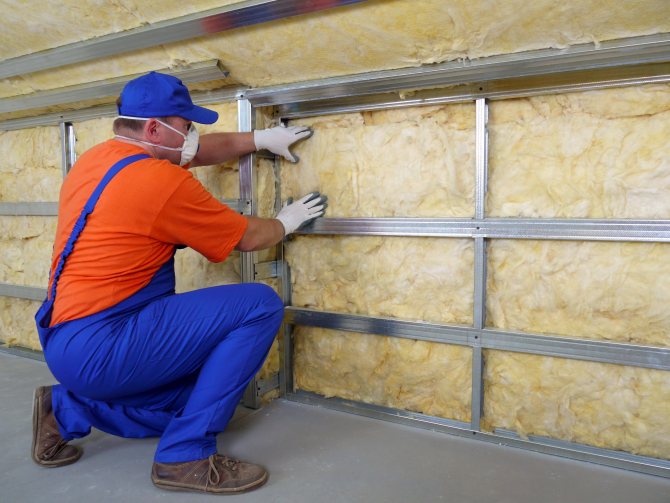

An important point is also the convenience in working with the material.
In addition to the fundamental selection parameters, there are many others, such as frost resistance, fire safety level, flexibility and much more.The general classification of thermal insulation materials is as follows:
- organic;
- inorganic;
- mixed.
All types of heaters have their own characteristics, the specificity of production technologies in accordance with GOST and the scope of application. Using a comparison of advantages, and knowing about the possible "pitfalls" in the process of operation, you can make the only correct choice.
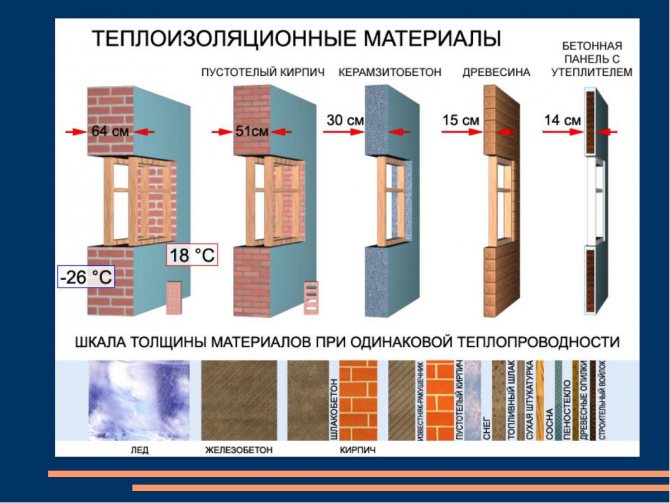

Each material has its own characteristics and characteristics.
Insulation recommendations
It is best to carry out insulation work in the summer, when the air humidity is minimal.
Walls for insulation in the room must be perfectly dry. You can dry them after additional plastering, finishing work to level the surfaces using construction hair dryers and heat guns.
Stages of surface insulation:
- Cleaning the surface from decorative elements - wallpaper, paint.
- Treatment of walls with antiseptic solutions, priming of the surface with deep penetration into the layers of plaster.
- In some cases, when installing polystyrene foam and electric heating elements, the walls are pre-leveled using waterproof bathroom plaster.
- Installation of insulation should be carried out in accordance with the instructions prescribed by the manufacturer for this type of material.
- Installation of a protective partition for applying the final finish, or covering the surface with construction mesh, plastering it.
- Creation of a single composition with the overall design of the room.
Insulating the walls inside the house is one of the most effective ways to protect your home from the penetration of cold and the negative effects of condensation, the main thing is to observe the technological sequence of stages. More details about the technology of insulating a home from the inside can be found in this material.

